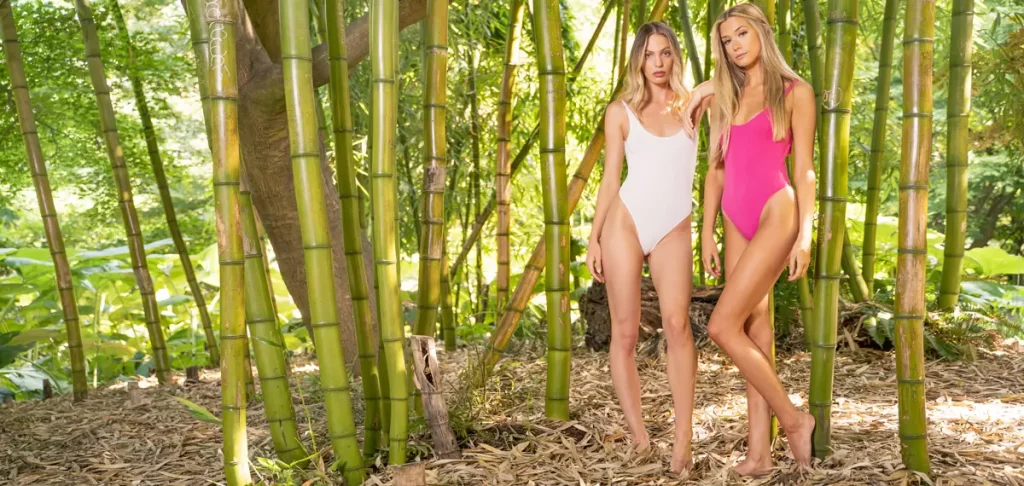Introduction to Bamboo vs Tencel Clothing
In the ever-evolving world of sustainable fashion, consumers are becoming more conscious of the materials used in their clothing. Two popular choices, bamboo and Tencel™ Lyocell, have emerged as front-runners in the Eco-friendly fabric landscape. In this blog post, we will delve into the differences between bamboo vs Tencel clothing. We focus on key factors such as performance, sustainability, and comfort
What is Bamboo Clothing?
Bamboo clothing is made from the pulp of bamboo grass, a plant known for its rapid growth and minimal need for pesticides and fertilizers. Although bamboo exhibits wood-like fibers, it is botanically classified as a grass rather than a tree. The fabric derived from bamboo is known for its softness and durability. It’s a breathable material that wicks moisture away from the skin, making it a great choice for activewear or summer clothing. Bamboo’s natural antibacterial properties also mean that clothes made from this material can stay fresher for longer.
What is Tencel Clothing?
Tencel is a brand name for a type of lyocell, a fiber made from the wood pulp of trees, primarily eucalyptus, beech, birch and more harvested from sustainable forests. The process of turning wood pulp into Tencel fabric is praised for its environmentally responsible closed-loop system, which recycles water and solvents. Tencel clothing is not only soft, breathable, and moisture-wicking but also boasts a luxurious drape that makes it suitable for premium active and athleisure clothing.
Shared Benefits
Both bamboo and Tencel are celebrated for their:
- Softness: They provide a smooth feel, which is gentle on the skin.
- Breathability: Excellent for temperature regulation.
- Antibacterial Properties: Naturally repel bacteria, making them odor-resistant.
- Moisture Wicking: Efficiently absorb and evaporate sweat.
- Hypoallergenic: Ideal for sensitive skin.
- Sustainability: Their production processes are more eco-friendly compared to traditional fabrics.
Differences
While they share many benefits, there are some notable differences:
| Feature | Bamboo | Tencel |
|---|---|---|
| Cost | Generally more affordable | More expensive due to its production process |
| Production Sustainability | Not always processed in a responsible way | Utilizes a closed-loop process, recycling water and solvents |
Performance
Bamboo and Tencel™ Lyocell both boast impressive performance characteristics, making them sought-after materials for modern clothing. Both fabrics naturally breathe and wick moisture, ensuring the wearer stays cool and dry in any climate. Both fabrics are also known to be gentle on sensitive skin, making them ideal choices for those with allergies or skin sensitivities
Sustainability
One of the primary reasons consumers turn to bamboo and Tencel™ Lyocell is their eco-friendly credentials. Bamboo is a rapidly renewable resource that requires minimal water and pesticides, making it a sustainable choice. Concerns arise about chemical processes turning bamboo into fabric, potentially offsetting its green benefits. Tencel™ Lyocell, on the other hand, is made from wood pulp, typically sourced from sustainably managed eucalyptus, beech or birch forests. The closed-loop production process used in manufacturing Tencel™ Lyocell minimizes environmental impact, earning it praise for its overall sustainability.

Comfort
Comfort is a crucial factor when choosing clothing, and both bamboo and Tencel™ Lyocell excel in this department. Bamboo and Tencell™ fabrics are soft and smooth, with a luxurious feel against the skin. Their temperature-regulating properties make it suitable for various weather conditions. Both fabrics boast a silky texture, luxurious drape, and excellent breath-ability. Additionally, the fabric’s moisture-wicking capabilities contribute to a comfortable and dry wearing experience. Ultimately, the choice between bamboo and Tencel™ Lyocell is very difficult to tell them apart as they both feel almost identical
Conclusion of Bamboo vs Tencel Clothing
In the quest for a more sustainable wardrobe, bamboo and Tencel™ Lyocell stand out as eco-friendly fabric choices. Each material has its unique set of advantages, from bamboo’s natural breathability to Tencel™ Lyocell’s sustainable production process. When it comes to performance, sustainability, and comfort, both fabrics have their merits, offering consumers a greener alternative to traditional clothing materials. As the fashion industry continues to embrace sustainability, the choice between bamboo and Tencel™ Lyocell ultimately depends on individual preferences and priorities in the pursuit of a more environmentally conscious lifestyle.
Read more about here why we use Tencel™ Lyocell in our clothing.

Leave a Reply